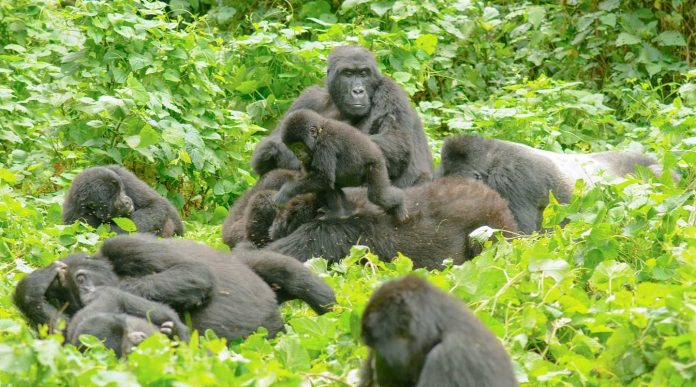Looking for a perfect destination to track the gorillas from? Uganda should be your first priority as it covers almost three thirds of the total population of mountain gorillas in the world. Tracking the gorillas is somehow a challenging activity but the experience achieved from it, is of a lifetime and you are surely guaranteed with memorable escapades. On meeting these giant yet humble apes in their territory, it will arguably be worth your effort as no one can fully describe the fantastic moment attached to the first sight on a wild mountain gorilla. It is to be noted that; among all the gorilla types in the world, Uganda only resides one type, which is the eastern mountain gorilla (rare endangered mountain gorillas) and it resides it more than any other country in the world.
Where to track the mountain gorillas in Uganda
The world comprises of only four national parks which protect the lives of the rare endangered mountain gorillas, and the most fascinating thing is that Uganda has two of the four national parks. These Parks include; Virunga National Park (in DR Congo), Volcanoes National Park (in Rwanda), and then the two Parks in Uganda; Bwindi Impenetrable National Park and Mgahinga Gorilla National Park. Therefore, the mountain gorillas in Uganda can only be tracked from Bwindi and Mgahinga, of which both Parks are perched in the South-western parts of the country.
Location, History and Accessibility of Bwindi
Bwindi, found in south-western Uganda, was gazetted as a national park in 1991 and declared a UNESCO natural world heritage site in 1994. The Park is composed of 331 square kilometers (128 square miles) of both montane and lowland forests. Accessing Bwindi by Road from Kampala, Uganda’s capital, it is a 6-8 hours’ drive; a route through Kampala to Mbarara and then converging to Butogota, a mere 17 kilometers from the Buhoma entrance gate. Always remember to book your gorilla safari in advance with your tour agency such that it reserves you a good quality 4X4 tourist vehicle that you will use for transportation, such as; Land Cruisers TX, Land Cruisers V8, Land Cruisers VX, Land Cruisers JX, Extended Land Cruisers with pop-up roofs, Safari Vans, Costa buses, Super Customs, and Rav4s, among others. Bwindi can also be accessed from Queen Elizabeth National Park to the north through Ishasha sector, which is a 2-3 hours drive, or from Kabale town to the south, just a 1-2 hours’ drive.
Bwindi can also be accessed by Air flying from Kampala, Entebbe Airport or Kajjansi Airfield, to the modern tarmac airstrip at Kisoro. Planes can too be chartered to the grass Kayonza or Savannah airstrips. Bwindi comprises of three airfields; at Kayonza and Kihiihi, for those going to track in the northern sector, and Nyakabande, in Kisoro, for those going to track gorillas in the southern sectors.
Location, History and Accessibility of Mgahinga
In the South-western parts of Uganda (Kisoro District) is where Mgahinga National Park lies. Though it is the smallest national park in Uganda, covering a total area of 33.7 square kilometers, Mgahinga is one of the only four Parks in the world protecting the rare endangered mountain gorillas that inhabit the dense forests of the Park, and besides protecting the endangered mountain gorillas, Mgahinga is also known for keeping the endangered golden monkeys. The Park commands majestic natural beauty and its annual visitors always enjoy the beautiful views over the Park’s three volcanoes; Muhavura, Mgahinga, and Sabinyo volcanoes. On addition to gorilla and golden monkey trekking, hiking any of the above volcanoes is also an experience of its own, especially the Mgahinga volcano of which you will only pay US$ 80 to hike it.
Accessing Mgahinga from Kampala, it takes 8-10 hours driving on the good tarmac roads up to Kabale or Kisoro towns covering about 482 kilometers. From Kisoro town, the dirt road covers 14 kilometers to the park and another route goes along the shorelines of the beautiful Lake Bunyonyi. Ntebeko is the only entrance gate open from 07:00am to 06:00pm all year round. However, the Park can also be accessed by air as the charter schedule flights depart from Entebbe Airport or Kajjansi Airfield in Kampala and land at Kisoro Airstrip, of which from there it is a one hour drive to the Park.
Habituated gorilla family in Mgahinga
Mgahinga is a home to almost 100 mountain gorilla individuals but due to various conservation reasons, there is only one habituated gorilla family that is open to trekkers. Nyakagezi gorilla family, comprising of 10 members (gorilla individuals), is the only renowned habituated gorilla family in Mgahinga National Park. The gorilla family is led by a silverback known as Mark and being assisted by another silverback called Mafia. Out of the 10 gorilla individuals in the family, there are; 3 Silverbacks, 2 Black-backs, 2 Females, 2 Juveniles and one Baby-Toddler.
Habituated gorilla families in Bwindi
As of now, Bwindi Impenetrable Forests National Park comprises of over 500 mountain gorillas, which is almost half of the total number of mountain gorillas left in the world. The Park consists of 18 habituated gorilla families and these families reside and are trekked from the Park’s four sectors; Buhoma sector, Rushaga sector, Ruhija sector, and Nkuringo sector. These gorilla families are; Mubare, Rushegura, Habinyanja and Katwe (in Buhoma); Bweza, Nshongi, Mishaya, Mucunguzi, Busingye, Kahungye, Bikyinji and Bushaho (in Rushaga); Oruzogo, Kyaguriro, Mukiza, and Bitukura (in Ruhija); and then Nkuringo and Christmas (in Nkuringo sector). Mubare gorilla family, boasting 5 gorilla individuals, is however the oldest habituated gorilla family in Bwindi and Uganda at large and thus trekking this family is much adorable.
Gorilla Permit in Uganda
For one to go trekking the mountain gorillas in any of the country’s gorilla trekking Parks will need to owe a Uganda gorilla trekking permit which costs quite affordable as compared to that of Rwanda. A Uganda gorilla permit costs US$ 600 per person and this will be acquired for you by your tour agency however due to the high demand of the permit, especially in the peak season, you are highly advised to consider advance booking. It is on your arrival in Uganda after settling all your safari’s bills that the permit will be handed over to you and you will need to represent it at the Park’s entrance gate – as it even includes the Park entrance fees and thus you will not need to pay any extra charge for the entrance fee as long as you posses a permit.
Accommodations in Bwindi and Mgahinga
Bwindi National Park comprises of various accommodations ranging from budget, mid-range and luxury accommodations which include; Buhoma lodge, Lake Kitandara Bwindi Camp, Sanctuary Gorilla Forest Camp, Silverback Lodge, Volcanoes Safaris Bwindi Lodge, The Gorilla Resort, Mahogany Springs Lodge, and Buhoma Community Rest Camp (in Buhoma sector); Nshongi Camp, Gorilla Valley Lodge, Rushaga Gorilla Camp, Ichumbi Gorilla Lodge, and Gorilla Safari Lodge (in Rushaga Sector); Bakiga Lodge, Gorilla Mist Camp, Gift of Nature Lodge, Ruhija Gorilla Safari Lodge, Broadbill Forest Camp, Ruhija Gorilla Friends Resort & Campsite, and Trekkers Tavern Lodge (in Ruhija sector); Nkuringo Bwindi Gorilla Lodge, Clouds Mountain Gorilla Lodge, Mutanda Lake Resort, Wagtail Eco Safari Camp, and Bwindi Backpackers Lodge (in Nkuringo sector).
Accommodations in Mgahinga National Park are also many and some of them include; Mgahinga gorilla lodge, Mgahinga Community Camp Ground, Virunga Hotel, Mgahinga Rest camp, Travelers Rest House, and Kisoro tourist hotel, among others.
Rules and Regulations to follow during gorilla trekking expeditions
-Trekkers will only be given one hour to spend with the gorillas once met.
-Keep a distance of at least 6 to 8 meters while viewing the gorillas because a close intact with them may lead to spread of some air diseases from you to them, as we share almost the same DNA with them, and also since these primates are wild creatures, however much how friendly they are to us, you should at least view them from a certain distance for security purposes.
-Gorilla trekking is done in groups of 8 individuals per trekking group.
-Minimize your voices while tracking the gorillas because high voices will scare the primates hence failing to meet them.
-Do not use flashlight cameras while taking photos of the gorillas as the flashlights may scare the primates while you are still viewing them.
-Do not litter the Park.
-Do not smoke or eat from the Park.
-Do not mimic the gorillas as you may not know what you are communicating to them.
– Arrive at the Park headquarters earlier (at 07:30am) for briefings and to be given your trekking group – the gorilla trekking activity starts at 08:30am.
The Best Time to Go For Gorilla Trekking In Uganda
For all gorilla lovers all over the world should take note that; though the gorilla trekking activity is regarded as an all-year-round-activity, there is a best time during the year that the gorilla trekking expeditions be more joyous. The most ideal time to go for gorilla trekking expeditions in Uganda is during the Country’s two dry seasons; January to February, and then June to October, reason being that; since the roads linking to the Parks are dirt, they become easier to pass through in dry seasons as they become slippery in the wet seasons and passing through these slippery dirt roads becomes a hurdle. Still trekking the gorillas in the thick forests of Bwindi and Mgahinga becomes more enjoyful and easier during the dry seasons when it is not raining in the Parks.
What to Pack for a Gorilla Safari in Uganda
There are some vital things that you should not forget to pack while going for a gorilla safari and here is the guide on what you should pack; a yellow fever vaccination, water-proof walking/hiking boots, wet weather clothing and warm layers as the weather is at times unpredictable and for the evening coldness, sun glasses, sun hat, water-proof bags to protect your belongings safely, good cameras together with extra charged batteries, energy-giving snacks and enough drinking water, garden gloves, and insect repellents, among others.




